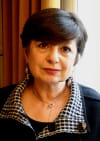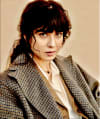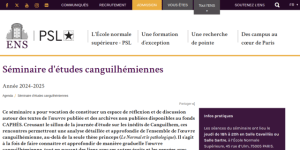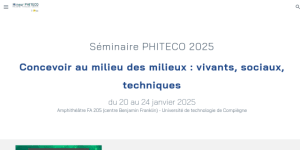La notion d'individuation renvoie à deux idées liées mais distinctes. Les individus forment des unités à peu près insécables, comme le terme l’indique et les individus sont distincts les uns des autres.
Archives
-
-
De la fonction du processus de synthèse
Nous analysons la fonction de la synthèse en partant de la production des connaissances en examinant ses opérations ainsi que ses dysfonctionnements contemporains. La montée d’un empirisme computationnel — fondé sur les protocoles standardisés, la production de données et la pression à publier — marginalise le travail théorique et empêche l’émergence de nouveaux cadres conceptuels. À partir du cas de la biologie, nous montrons que l’activité synthétique ne subsiste principalement que dans les articles de revue, nécessairement conservateurs, ce qui conduit à l’accumulation de contradictions et à la prolifération de métaphores et de concepts zombies. Nous identifions ensuite les conditions matérielles et organisationnelles de la synthèse, en mobilisant l’analogie des systèmes vasculaire et nerveux pour décrire l’intégration des processus locaux en unités globales cohérentes. Enfin, nous caractérisons la synthèse comme un processus anti-entropique, producteur de singularités fonctionnelles et garant d’une unité épistémique ; son érosion favorise le morcellement intellectuel et l’incohérence institutionnelle.
-

Le défi épistémologique de l’intégration entre la systématique et le reste de la biologie
La systématique donne, de fait, le système de référence de la biologie permettant de désigner ses objets, mais cet état de fait manque d'une intégration conceptuelle, épistémologique et méthodologique. Des domaines comme la génétique des population, l'écologie théorique, la biologie moléculaire ou la biologie des systèmes, en effet, s'appuient sur les relations causales synchroniques chez les être vivants. Ceci est particulièrement clair lorsque l'on considère leurs modèles mathématiques, largement hérités de la physique pour ce qui est de leurs structures et de leurs épistémologies. Surmonter cet obstacle épistémologique suppose de repenser le cadre théorique de la biologie comme un cadre épistémologiquement hybride, entre cadre historique et cadre relationnelle et synchronique, et de développer une écriture théorique et des méthodes adaptées.
-
Disruptions et théorie de la récapitulation pour penser l’éducation
-

Biology lies between historical and relational frameworks
-

Spherical cows and bipedal goats: Perspectives on mathematical models in biology
This event aims to take a step back and reflect on everyday mathematical modeling. We aim to organize a discussion on the diversity of this practice in biology and the homologies in current models. We wish to center those discussions around two related problems. First, given that the general reference system of biology builds on a notion of novelty to classify living beings, how can we use mathematical structures (using predefined spaces of possibilities) to describe living beings while avoiding contradiction? Is it reasonable that many of these practices do not even consider the organization of the organisms? Second, if models can be considered as instruments that contribute to shaping scientific reasoning, is their inscription within broader theoretical frameworks (not) necessary? Are data-based approaches sufficient to understand the living, or should theoretical and methodological jumps be performed? Is the perspective of the National Research Council sound when it states that not all New Biologists are now, or will in the future be, biologists? How to take mathematics and modelling seriously and, at the same time, avoid the disruption of biological knowledge by the fetishization of those tools?
-
Disruptions in biology: Theorizing a hallmark of the anthropocene
Biologists often use the term "disruption" informally to describe the effects of detrimental anthropogenic causes. A proper concept of disruption should be distinct from perturbations or, in ecology, from generic disturbances. We illustrate this with examples from ecology, using the case of plant-pollinator networks, from organismal biology, with endocrine disruptors, and at the interface of psychological and cognitive development with digital media and young children. Specifically, we argue that understanding disruptions requires the articulation of historical and relational reasoning. The object of disruption, such as endocrine regulation or seasonal synchrony between plants and pollinators, is a specific property coming from history that is disturbed in a new, random way, leading to a loss or degradation of this specificity. Moreover, initially, this specificity plays a specific relational role, typically a functional one. This role is lost or impaired by the disruption, which explains the disorganization characteristic of disruptions. In our view, however, disruptions are a normal part of the evolutionary process. What is severely detrimental in the Anthropocene is the accumulation of disruptions at a pace that exceeds the ability of living entities to overcome them.
-

Theory and theorization in the sciences
To a large extent, the question of theoretical frameworks in the sciences has been neglected (or poorly treated) in philosophy. In parallel, we argue that scientists themselves are currently neglecting this question, and we will show the consequences of this situation in biology. We will then provide elements of the definition of scientific theories, which are partly grounded in the activity of theorization itself. We will articulate this discussion with the question of the function of theories and theorization in the sciences.
-

Séminaire sur le vivant 2025-2026
Perpétuant les orientations impulsées par Jean-Jacques Kupiec lors de sa création, le séminaire Cavaillès se donne pour objet l'histoire et la philosophie des sciences du vivant. Une fois par mois un acteur des sciences expérimentales ou humaines est invité à y présenter ses travaux et réflexions. Le séminaire se veut ouvert à toutes et à tous, avec l'objectif de croiser les regards, partager les connaissances et favoriser les échanges sur un large spectre de thématiques et de questions. Il entend être le témoin de la vitalité, l'actualité et la fertilité des recherches en épistémologie historique des sciences biomédicales, ainsi que de leur incidence sur les débats scientifiques contemporains.
-

Quantitative analysis of endocrine disruption by ketoconazole and diethylstilbestrol in rat mammary gland development
Reproductive Toxicology
we look into the effect of endocrine disruptors on rat mammary glands
Abstract
Endocrine disruptors alter mammary gland development, impair the ability to nourish offspring, and increase the cancer risk in animal models. Epidemiological studies reveal trends towards early mammary development, nursing problems, and breast cancer in younger women. Morphological changes in mouse postnatal mammary gland development are considered sensitive markers of endocrine disruption. While the mouse mammary gland is easily amenable to morphometric measurements from the fetal stage to full maturity, the rat mammary gland grows more conspicuously into the third dimension, hindering conventional morphometric analysis. However, since rats are more commonly used in international toxicological reproductive studies, it would be beneficial to include mammary gland whole-mount analysis in these studies. Using our quantitative software to perform computer-driven analysis of the rat mammary epithelium we examined the effects of gestational and postnatal exposure to ketoconazole, an antifungal medication that affects steroidogenesis, and to the estrogen diethylstilbestrol in the mammary glands of 6- and 22-day-old females. Both treatments produced effects at both ages; the epithelium was smaller and less complex in exposed animals compared to controls. Global analysis with the permutation test showed that morphological evaluation of the PND22 mammary gland is sensitive to endocrine disruption and possibly non-monotonic. In addition to revealing that ketoconazole altered the mammary gland structure, these results suggest that for future toxicology studies, day 22 (at weaning) is more suitable than day 6 because it showed significant measurements and trends. If the collection of mammary glands is added to existing international test methods, PND22 could be a relevant time point.
Keywords: Ketoconazole, Diethylstilbestrol, endocrine disruptors, perinatal exposure, mammary gland whole mount
Manuscript Citation Publisher Full textCitation
Montévil, Maël, Cheryl Schaeberle, Julie Boberg, Sofie Christiansen, and Ana M. Soto. 2025. “Quantitative Analysis of Endocrine Disruption by Ketoconazole and Diethylstilbestrol in Rat Mammary Gland Development.” Reproductive Toxicology 135 (August): 108929. https://doi.org/10.1016/j.reprotox.2025.108929 -

How does randomness shape the living?
Figures of chance II chance: In theory and practice
In biology, randomness is a critical notion to understand variations; however this notion is typically not conceptualized precisely. Here we provide some elements in that direction.
Abstract
Physics has several concepts of randomness that build on the idea that the possibilities are pre-given. By contrast, an increasing number of theoretical biologists attempt to introduce new possibilities, that is to say, changes of possibility space – an idea already discussed by Bergson and that was not genuinely pursued scientifically until recently (except, in a sense, in systematics, i.e, the method to classify living beings).
Then, randomness operates at the level of possibilities themselves and is the basis of the historicity of biological objects. We emphasize that this concept of randomness is not only relevant when aiming to predict the future. Instead, it shapes biological organizations and ecosystems. As an illustration, we argue that a critical issue of the Anthropocene is the disruption of the biological organizations that natural history has shaped, leading to a collapse of biological possibilities.Manuscript Citation Publisher Full textCitation
Montévil, Maël. 2025. “How Does Randomness Shape the Living?” In Figures of Chance II Chance: In Theory and Practice, edited by Anne Duprat and Alison James, 477–531. London / New York: Routledge. https://doi.org/10.4324/9781003329060-4 -
Disruptions: A specific kind of disorganization
Biologists often use the term disruption more or less informally; however, this notion is increasingly used to describe the effects of detrimental anthropogenic causes. We argue that disruptions are distinct from perturbations or, in ecology, from generic disturbances. We illustrate this with examples from ecology using the case of plant-pollinator networks and organismal biology with endocrine disruptors. Specifically, we argue that understanding disruptions requires the articulation of historical and relational reasoning. The object of disruption, such as endocrine regulation or seasonal synchrony between plants and pollinators, is a specific property coming from history that is disturbed in a new way, leading to a loss or degradation of this specificity. Moreover, initially, this specificity plays a specific relational role, typically a functional one. This role is lost or impaired by the disruption which explains the disorganization characteristic of disruptions. In our view, however, disruptions are normal processes in evolution. What is severely detrimental is the current accumulation of disruptions at a pace that exceeds living entities' ability to overcome them.
-
Concepts and principles for the new biology: Development, disruption and normalization
During the first 25 years of the 21st century, we witnessed a resurgence of Organicism. This process is characterized by the return of the organism as a central biological entity and the increasing investigation on purpose and normativity at this level.
Simultaneously, the issue of the vulnerabilities of living beings and their numerous disruptions is escalating in urgency. The need to comprehend these disruptions, and how living beings adapt to them, is pressing. Organicism, with its systemic approach to disruptions and its focus on organisms’ normativity, is the most suitable framework for this understanding.
In this session, we will:
1) explore the epistemological role played by the morphogenetic field concept in the studies on the etiology of tumors in the early 20th century and its resurgence in the organicist conception of cancer as development gone awry (presented by Claudia Gadaleta, Paris 1 Sorbonne Panthéon - IHPST, Paris, France),
2) argue that a properly fleshed-out concept of disruption describes the effects of a significant category of detrimental anthropogenic causes in organisms and ecosystems. Understanding disruptions requires articulating historical and relational reasoning, which is a hallmark of recent theoretical developments (presented by Maël Montévil, Centre Cavaillès, Ecole Normale Supérieure, Paris, France)
3) argue that disruption causes a loss of function. The organismal agency may overcome disruption by acquiring novel functions, a process we call normalization. We will discuss two examples: i) how young quadrupeds that lost the function of their forelimbs teach themselves to walk as bipeds, and ii) cancer, a disease usually perceived as irreversible but known to regress spontaneously by normalization (presented by Ana Soto, Tufts University, USA and Centre Cavaillès, Ecole Normale Supérieure, Paris, France). -
Organization and variation as theoretical principles for biology
-

De la fonction du processus de synthèse
-
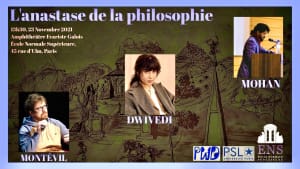
The concept of field in philosophy
-

Comment le hasard façonne le vivant ?
Le hasard. Littérature, arts, sciences, philosophie
En biologie, le hasard est une notion essentielle pour comprendre les variations ; cependant, cette notion n'est généralement pas conceptualisée avec précision. Nous apportons ici quelques éléments allant dans ce sens.
Abstract
La physique possède plusieurs concepts de hasard qui reposent néanmoins tous sur l’idée que les possibilités sont données d’avance. En revanche, un nombre croissant de biologistes théoriciens cherchent à introduire la notion de nouvelles possibilités, c’est-à-dire des modifications de l’espace des possibles - une idée déjà discutée par Bergson et qui n’a pas été véritablement poursuivie scientifiquement jusqu’à récemment (sauf, en un sens, dans la systématique, c’est-à-dire la méthode de classification des êtres vivants).
Alors, le hasard opère au niveau des possibilités elles-mêmes et est à la base de l’historicité des objets biologiques. Nous soulignons que ce concept de hasard n’est pas seulement pertinent lorsqu’on cherche à prédire l’avenir. Au contraire, il façonne les organisations biologiques et les écosystèmes. À titre d’illustration, nous soutenons qu’une question cruciale de l’Anthropocène est la disruption des organisations biologiques que l’histoire naturelle a structurées, conduisant à un effondrement des possibilités biologiques.Manuscript Citation Publisher Full textCitation
Montévil, Maël. 2025. “Comment Le Hasard Façonne Le Vivant ?” In Le Hasard. Littérature, Arts, Sciences, Philosophie, edited by Anne Duprat, Fiona McIntosh‑Varjabédian, Anne‑Gaëlle Weber, and Alison James, 505–16. Paris, France: CNRS Éditions. https://www.cnrseditions.fr/catalogue/philosophie-et-histoire-des-idees/le-hasard/ -

Disruption of biological processes in the anthropocene: The case of phenological mismatch
Acta Biotheoretica
Biologists are increasingly documenting anthropogenic disruptions, both at the organism and ecosystem levels, indicating that these disruptions are a fundamental, qualitative component of the Anthropocene.
Abstract
Biologists are increasingly documenting anthropogenic disruptions, both at the organism and ecosystem levels, indicating that these disruptions are a fundamental, qualitative component of the Anthropocene. Nonetheless, the notion of disruption has yet to be theorized. Informally, disruptions are direct or indirect consequences of specific causes that impair the contribution of parts of living systems to their ability to last over time. To progress in this theorization, we work here on a particular case. Even relatively minor temperature changes can significantly impact plant-pollinator synchrony, disrupting mutualistic interaction networks. Understanding this phenomenon requires a specific rationale since models describing it use both historical and systemic reasoning. Specifically, history justifies that the ecosystem initially exists in a very narrow part of the possibility space where all its populations are viable, and the disruption leads to a more generic configuration where some populations are not viable. Building on this rationale, we develop a mathematical schema inspired by Boltzmann’s entropy, apply it to this situation, and provide a technical definition of disruption.
Manuscript Citation Publisher Full textCitation
Montévil, Maël. 2025. “Disruption of Biological Processes in the Anthropocene: The Case of Phenological Mismatch.” Acta Biotheoretica 73 (2): 5. https://doi.org/10.1007/s10441-025-09496-2 -
Extension du domaine de soin
Ce séminaire a pour vocation de constituer un espace de réflexion et de discussion autour des textes de l’œuvre publiée et des archives non publiées disponibles au fonds CAPHÉS. Creusant le sillon de la journée d’étude sur les inédits de Canguilhem, ces rencontres permettront une analyse détaillée et approfondie de l’ensemble de l’œuvre canguilhémienne, au-delà de la seule thèse princeps (Le Normal et le pathologique). Il s’agit à la fois de faire connaître et approfondir de manière graduelle l’œuvre canguilhémienne, tout en nouant des liens avec ses autres écrits et les pensées avec lesquelles il entre en dialogue ou lorsque ce n’est pas le cas recueillir les échos, que ses idées rencontrent chez d’autres penseurs et chez d’autres disciplines.
-
Quelques défis théoriques et épistémologiques entre biologie et conception orientée milieu
La biologie théorique contemporaine prend en charge et renouvelle certaines questions fondamentales : notamment la question de l’historicité et la question des niveaux d’organisation – ainsi que le sens accordé à ce dernier terme. Nous présenterons certaines avancées dans ce domaine qui recoupent les questionnements et les défis rencontrés dans la conception orientée milieu.



